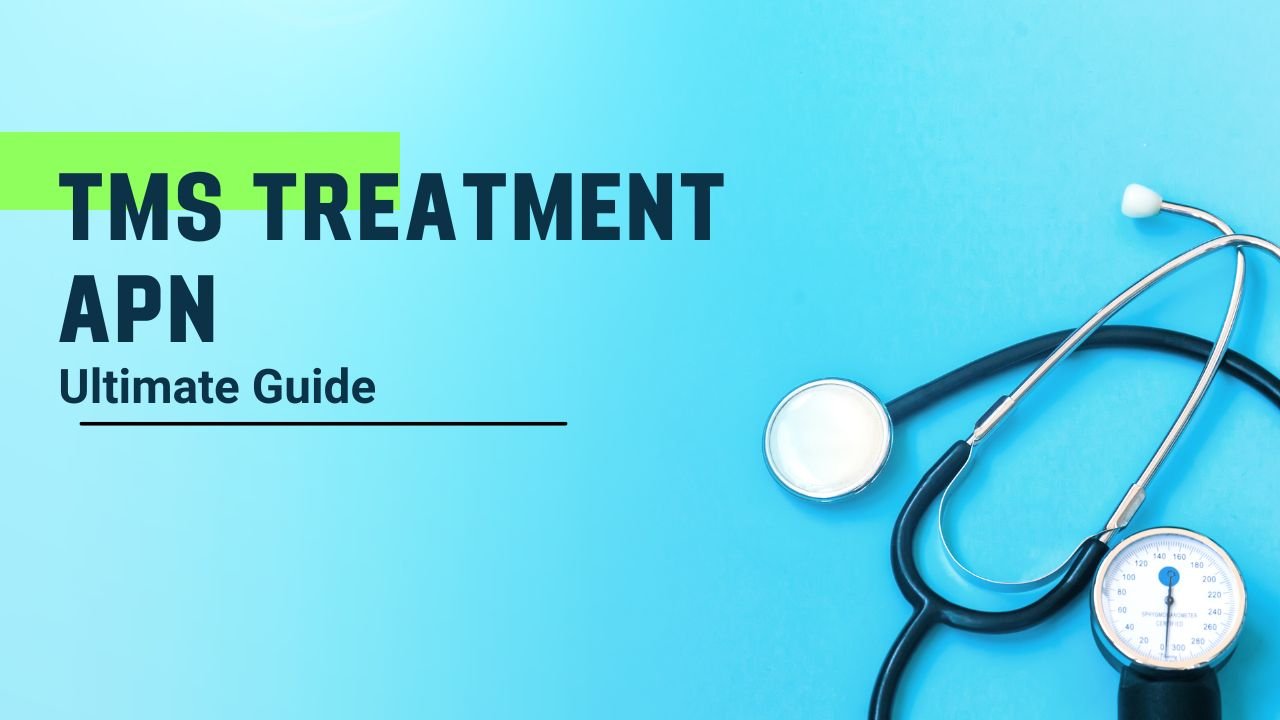TMS Treatment APN , also known as Transcranial Magnetic Stimulation, is a non-invasive method used to treat certain mental health conditions, particularly depression. The process involves using magnetic fields to stimulate nerve cells in the brain, specifically targeting areas involved in mood regulation.
This treatment is typically recommended for individuals who haven’t responded well to other treatments, like medication or therapy. During a TMS session, a coil is placed on the scalp near the forehead, sending magnetic pulses to the brain. These pulses help activate the brain’s nerve cells, potentially leading to improved mood and mental health. TMS is considered a safe and effective option for many people, offering hope to those who haven’t found relief through other means.
How Does TMS Treatment Work?
The TMS Treatment APN works by targeting the prefrontal cortex, a part of the brain that’s often less active in individuals with depression. By delivering magnetic pulses to this area, the treatment helps to stimulate nerve cells, which can improve communication between different parts of the brain.
This process is believed to help regulate mood and alleviate symptoms of depression. The treatment is usually administered over several weeks, with sessions lasting around 30 to 40 minutes each. Unlike other treatments, TMS doesn’t require anesthesia, and patients remain awake during the procedure.
The technology behind TMS is based on the principles of electromagnetic induction, which allows the magnetic fields to penetrate the scalp and reach the brain without causing pain or discomfort.
Who Can Benefit from TMS Treatment?
TMS Treatment APN is particularly beneficial for individuals with major depressive disorder (MDD) who haven’t responded well to antidepressants or other forms of therapy. It’s also an option for those who experience side effects from medication and are looking for alternative treatments.
TMS is generally recommended for adults, but it’s important to consult a healthcare provider to determine if it’s the right choice. The treatment has also shown promise in helping individuals with anxiety, obsessive-compulsive disorder (OCD), and post-traumatic stress disorder (PTSD). However, it’s most commonly used for treating depression.
Before starting TMS, a thorough evaluation is conducted to ensure the patient is a good candidate for the treatment, considering factors such as medical history, the severity of symptoms, and previous treatments.
What Are the Side Effects of TMS Treatment?
While TMS Treatment APN is generally safe and well-tolerated, there are some potential side effects. The most common side effects include headaches, scalp discomfort, and lightheadedness, which usually diminish after a few sessions.
In rare cases, TMS may cause more serious side effects, such as seizures, particularly in individuals with a history of epilepsy. However, the risk of seizures is very low, and most people do not experience significant side effects.
It’s important for patients to discuss any concerns with their healthcare provider before starting TMS. The treatment is non-invasive, meaning it doesn’t involve surgery or require recovery time, which makes it a more appealing option for those looking to avoid the side effects associated with medication.
How Effective is TMS Treatment?
TMS Treatment APN has been found to be an effective option for many individuals with treatment-resistant depression. Studies have shown that a significant percentage of patients experience improvement in their symptoms after completing a course of TMS. Some patients may experience remission, where their symptoms are completely alleviated.
The effectiveness of TMS can vary from person to person, depending on factors such as the severity of their condition and how they respond to the treatment. While TMS is not a cure for depression, it can provide long-term relief for many people.
Some patients may require maintenance sessions after the initial treatment course to maintain the benefits. Overall, TMS offers a promising option for those who haven’t found success with other treatments.
What is the Procedure for TMS Treatment?
The TMS Treatmen APNt procedure is straightforward and typically performed in an outpatient setting. Before the treatment begins, the healthcare provider will determine the correct placement of the magnetic coil on the patient’s head. This involves mapping the brain to identify the target area, usually the left dorsolateral prefrontal cortex.
Once the placement is determined, the patient will sit in a chair, and the coil will be positioned on their scalp. During the session, magnetic pulses are delivered to the brain, which may cause a tapping sensation on the scalp.
Each session lasts about 30 to 40 minutes, and patients can resume their normal activities immediately afterward. The treatment is usually administered five days a week over a period of four to six weeks.
What Are the Pros and Cons of TMS Treatment?
TMS Treatment APN offers several benefits, but it also has some limitations. Understanding these can help individuals make an informed decision about whether TMS is the right option for them.
| Pros | Cons |
| Non-invasive procedure | Multiple sessions required |
| No anesthesia needed | Can cause mild headaches |
| Minimal side effects | May not work for everyone |
| Effective for treatment-resistant depression | Can be expensive without insurance coverage |
| No recovery time | Some patients may need maintenance sessions |
How to Prepare for TMS Treatment?
Preparing for TMS Treatment APN involves a few simple steps to ensure the best possible outcome. Before starting the treatment, patients will undergo a comprehensive evaluation by a healthcare provider.
This assessment helps determine if TMS is the right treatment option. Patients may be asked to avoid certain activities or medications that could interfere with the treatment. It’s also important to discuss any concerns or medical conditions with the provider.
On the day of the treatment, patients should wear comfortable clothing and avoid using hair products like gels or sprays, as these can affect the magnetic pulses.
During the session, it’s essential to remain still and relaxed to ensure accurate delivery of the treatment. Following these guidelines can help improve the effectiveness of the treatment and minimize any potential side effects.
What to Expect After TMS Treatment?
After completing a course of TMS Treatment APN, patients may experience a gradual improvement in their symptoms. It’s important to note that the full benefits of the treatment may take a few weeks to become apparent.
Some patients may notice an improvement in mood and energy levels, while others may require additional sessions or maintenance treatments to achieve the desired results.
Follow-up appointments with the healthcare provider are essential to monitor progress and make any necessary adjustments to the treatment plan.
While TMS is a promising option for many people, it’s not a guaranteed cure, and some patients may continue to experience symptoms. However, for those who respond well to the treatment, TMS can provide long-lasting relief and improve overall quality of life.
Final Thoughts on TMS Treatment
TMS Treatment APN is a significant advancement in mental health care, particularly for individuals who haven’t found relief through traditional methods. By understanding how TMS works, who it benefits, and what to expect, patients can make informed decisions about their treatment options.
As with any medical treatment, it’s crucial to consult with a healthcare provider to determine if TMS is the right choice. While TMS may not be suitable for everyone, it offers hope to many people struggling with depression and other mental health conditions, providing a non-invasive, effective option that can improve lives.



